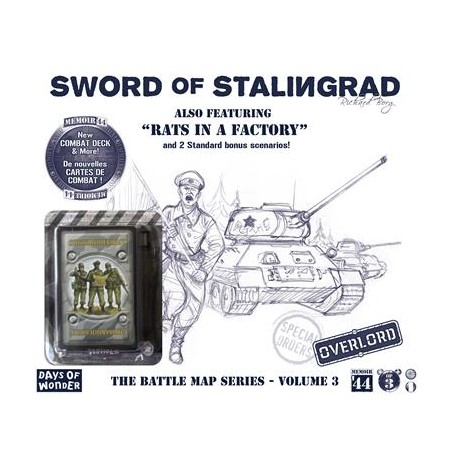- On order
- French
- -20%






Snowy weather conditions: delays in parcel dispatch and delivery are to be expected. Thank you for your understanding.



The third volume in the Battle Maps series for Memoir ‘44 includes two Overlord scenarios, two standard scenarios, summary maps from previous Battle Maps and maps of the Mediterranean Theatre. For the first time, it also includes new maps specially designed for urban combat.
The Sword of Stalingrad
At the end of August 1942, German troops reached the Volga, north of Stalingrad. It took the 4th Panzerarmee just a few days to reach the river south of the city, isolating the soldiers and civilians of the 62nd Soviet Army. Stalin's order of 27 July, ‘Not another step back’, was now engraved in the minds of the defenders. They soon realised that his slogan, ‘There's nothing behind the Volga’, reflected the harsh reality they were about to face.
Lieutenant-General Chuikov had witnessed the fearsome effectiveness of the German Blitzkrieg in the Russian steppes. He knew how to take advantage of the situation: the bombardments had reduced the city to a field of ruins, making it easy to set up defence lines overlooking the strategic streets and squares of Stalingrad. The Soviets had to fight as close to the enemy as possible, sometimes just a house or a door away, which prevented the Germans from using artillery or carrying out bombing raids.
Made like rats
By October 1942, Stalingrad had become a symbol for both Stalin and Hitler. The battle was now more a question of prestige than a real strategic issue. The entire eastern campaign focused on the city. In mid-October, the Luftwaffe stepped up its strikes against the Red Army units holding the west bank of the Volga. More than 2,000 air sorties were flown and 600 tonnes of bombs were dropped by Stukas on Stalingrad.
At the same time, three infantry divisions and two armoured divisions, supported by battalions of engineers, surrounded the three factories north of the city, aiming for the centre of the Soviet front line. The 14th Armoured Division broke through, almost completely isolating the tractor factory. The violence of this attack split the 62nd Soviet Army in two. General von Paulus realised that capturing the tractor factory would lead to the collapse of the Russian right flank. He therefore committed fresh troops to the battle to eliminate the Soviet defenders entrenched in the buildings.
Data sheet
Viewed products